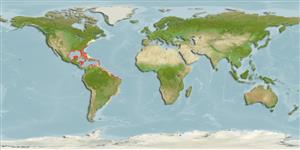Issue
Matsuura (2003: Ref. 53032) places this species in the genus Rhinesomus.
Environment: milieu / climate zone / depth range / distribution range
Ökologie
seewasser riff-verbunden; tiefenbereich ? - 50 m (Ref. 12204). Subtropical; 44°N - 35°S, 98°W - 34°W
Western Atlantic: Canada (Ref. 12204) and Massachusetts, USA to Brazil, including Bermuda, the Gulf of Mexico and the Caribbean.
Size / Gewicht / Alter
Maturity: Lm ? range ? - ? cm
Max length : 47.0 cm TL Männchen/unbestimmt; (Ref. 7251); common length : 20.0 cm TL Männchen/unbestimmt; (Ref. 3696)
Carapace and caudal peduncle blackish with numerous small white spots; lips and bases of fins blackish; terminal edge of caudal fin narrowly white with a blackish submarginal band (Ref. 13442).
Found on coral reefs (Ref. 12204). Solitary or in small groups (Ref. 9710). Feeds on a wide variety of small bottom invertebrates such as mollusks, crustaceans, worms, sessile tunicates and sponges exposed by a jet of water ejected through the mouth (Ref. 9710). Marketed fresh locally (Ref. 3696). Toxins released when excited kill other fishes (Ref. 5521). Easily approached (Ref. 9710).
Life cycle and mating behavior
Maturities | Fortpflanzung | Spawnings | Egg(s) | Fecundities | Larven
Coad, B.W., 1995. Encyclopedia of Canadian fishes. Canadian Museum of Nature and Canadian Sportfishing Productions Inc. Singapore. (Ref. 12204)
IUCN Rote Liste Status (Ref. 130435)
Bedrohung für Menschen
Reports of ciguatera poisoning (Ref. 30911)
Nutzung durch Menschen
Fischereien: weniger kommerziell; Aquarium: Kommerziell
Tools
Zusatzinformationen
Download XML
Internet Quellen
Estimates based on models
Preferred temperature (Ref.
123201): 22.7 - 28, mean 25.7 °C (based on 396 cells).
Phylogenetic diversity index (Ref.
82804): PD
50 = 0.6250 [Uniqueness, from 0.5 = low to 2.0 = high].
Bayesian length-weight: a=0.05012 (0.02762 - 0.09093), b=2.77 (2.60 - 2.94), in cm total length, based on LWR estimates for this species & (Sub)family-body (Ref.
93245).
Trophic level (Ref.
69278): 3.3 ±0.2 se; based on diet studies.
Widerstandsfähigkeit (Ref.
120179): hoch, Verdopplung der Population dauert weniger als 15 Monate. (Fec assumed to be > 10,000).
Fishing Vulnerability (Ref.
59153): Moderate vulnerability (37 of 100).
Nutrients (Ref.
124155): Calcium = 23.4 [9.0, 74.8] mg/100g; Iron = 0.603 [0.295, 1.440] mg/100g; Protein = 19.1 [16.8, 21.2] %; Omega3 = 0.16 [0.08, 0.31] g/100g; Selenium = 19.9 [8.5, 43.9] μg/100g; VitaminA = 23.1 [5.8, 100.8] μg/100g; Zinc = 0.683 [0.436, 1.092] mg/100g (wet weight);
